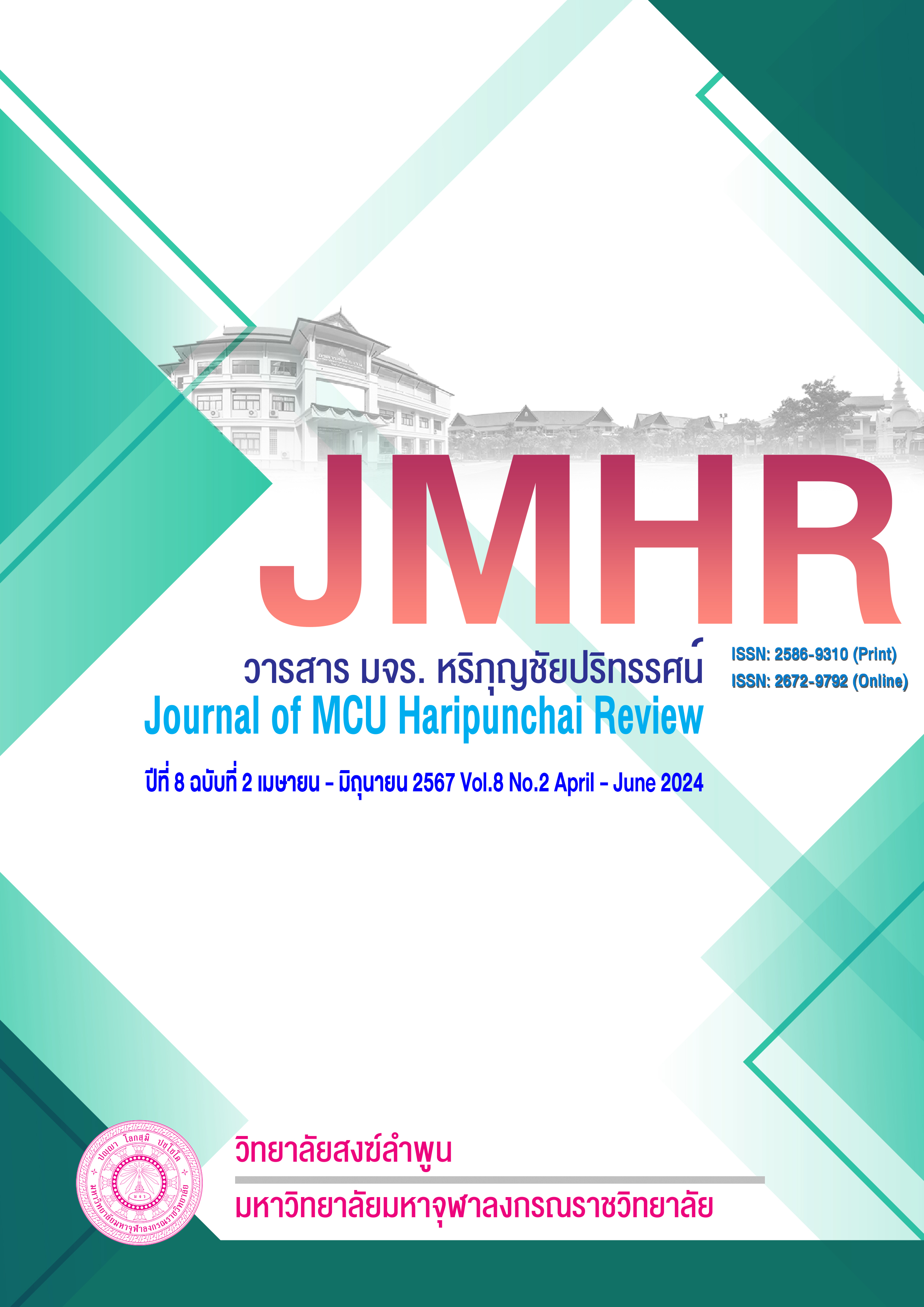The intellectual property violation: athinnāthāna in the digital age
Main Article Content
Abstract
This research article has three objectives: 1. To study intellectual property infringement in the digital era. 2. To study Athinnāthāna in Theravada Buddhism. 3. To analyze intellectual property infringement: Athinnāthāna in the digital era. It is research of documents from the Tripitaka, Commentary, and various research works, used to write analytical and descriptive narratives.
The results of the study found that:
1)Criminal and civil liability for infringers of intellectual property rights (copyright) is a concept in Western law. Intellectual property protection under two international laws that are party to it is the Berne Convention and the TRIPS Agreement. There are both criminal and civil punishments for violators. Criminal protection is a form of punishment by the state which includes three types of penalties: imprisonment, fines, and confiscation of assets.
2) Athinnāthāna in Theravada Buddhism is the prohibition of stealing. It is the second precept of a layperson and the second precept of a monk. If you violate the precept of Athinnāthāna, If you are a layperson, besides being immoral, you may be punished according to the laws of the country. If you are a monk, you may be liable according to the settlement rules. As for the benefits of refraining from Athinnāthāna, both laypeople and monks will receive two parts: 1) received while living will have good fortune, and 2) receive it after death He will be born in the heavenly world.
3) Infringement of intellectual property (copyright), which is a criminal and civil offense, amounting to 9 offenses. From the analysis, it was found that In the case of a layperson, the violation is Athinnāthāna. In the case of a monk, if the damage is more than 5 masaka, if the violation is done, he is considered parajik. But if the damage is less than 5 masks, it is not a crime but may be an offense, etc.
Article Details

This work is licensed under a Creative Commons Attribution-NonCommercial-NoDerivatives 4.0 International License.
References
กรมทรัพย์สินทางปัญญา, กระทรวงพาณิชย์. (2546). พระราชบัญญัติลิขสิทธิ์ พ.ศ.2537. กรุงเทพมหานคร : โรงพิมพ์องค์การรับส่งสินค้าและพัสดุภัณฑ์ (ร.ส.พ.).
ฉัตรรัตน์ ไชยจันทรัสม์. (2560). การละเมิดทรัพย์สินทางปัญญา. เอกสารวิชาการ. กลุ่มงานคณะกรรมาธิการการพาณิชย์และทรัพย์สินทางปัญญา สำนักกรรมาธิการ 1 สำนักงานเลขาธิการสภาผู้แทนราษฎร.
ชยุตม์ ศรีทิพย์โพธิ์. (2559). “ปัญหากฎหมายเกี่ยวกับผู้ทรงสิทธิบัตรร่วม”. วิทยานิพนธ์นิติศาสตรมหาบัณฑิต. คณะนิติศาสตร์. บัณฑิตวิทยาลัย : จุฬาลงกรณมหาวิทยาลัย.
ไชยยศ เหมะรัชตะ. (2562). ลักษณะของกฎหมายทรัพย์สินทางปัญญา. พิมพ์ครั้งที่ 12. กรุงเทพมหานคร : โรงพิมพ์ บริษัท เอ็น โฟร โปรพริ้น จำกัด.
ฐิติพร วัฒนชัย และ กิตติยา พฤกษารุ่งเรือง. (2562). “การบังคับคดีกับทรัพย์สินทางปัญญา” โครงการวิจัยการบังคับคดีกับทรัพย์สินทางปัญญา (เสนอกรมบังคับคดี กระทวงยุติธรรม). คณะนิติศาสตร์ มหาวิทยาลัยรามคำแหง. กรุงเทพมหานคร : มหาวิทยาลัยรามคำแหง.
บารมี วงษ์สมุทร. (2653). “ปัญหาทางกฏหมายเกี่ยวกับความรับผิดจากการละเมิดลิขสิทธิ์ของผู้ให้บริการพื้นที่บนสื่อสังคมออนไลน์”. วิทยานิพนธ์นิติศาสตรมหาบัณฑิต. สาขาวิชานิติศาสตร์. คณะนิติศาสตร์ปรีดี พนมยงค์. มหาวิทยาลัยธุรกิจบัณฑิตย์.
ประสาน โสมเสมสุวรรณ. (2560). “มาตรการทางกฎหมายในการคุ้มครองทรัพย์สินทางปัญญา : ศึกษากรณีการคุ้มครองลิขสิทธิ์ภาพยนตร์”. สารนิพนธ์นิติศาสตรมหาบัณฑิต. คณะนิติศาสตร์. บัณฑิตวิทยาลัย : มหาวิทยาลัยศรีปทุม.
ปริญญา ดีผดุง. (2546). พระราชบัญญัติลิขสิทธิ์ พ.ศ.2537 ที่แก้ไข. กรุงเทพมหานคร : สำนักพิมพ์จุฬาลงกรณมหาวิทยาลัย.
________. (2563). หลักกฎหมายลิขสิทธิ์และบทวิเคราะห์. กรุงเทพมหานคร : สำนักพิมพ์จุฬาลงกรณมหาวิทยาลัย.
พระมหาบุญมี ยโสธโร (คำลุน). (2549). “การศึกษาทัศนคติของเยาวชนที่มีต่ออทินนาทานในสังคมไทย: ศึกษาเฉพาะกรณี นักเรียนมัธยมศึกษาปีที่ 4-6 โรงเรียนภูเรือ จังหวัดเลย”. วิทยานิพนธ์พุทธศาสตรมหาบัณฑิต. บัณฑิตวิทยาลัย : มหาวิทยาลัยมหาจุฬาลงกรณราชวิทยาลัย.
พระมหาอิสระ สิงห์เปี้ย. “การวิเคราะห์ปัญหาอทินนาทานตามพุทธจริยศาสตร์เถรวาทในบริบทสังคมไทย”. วิทยานิพนธ์อักษรศาสตรมหาบัณฑิต. บัณฑิตวิทยาลัย : มหาวิทยาลัยมหิดล. 2545.
มหาจุฬาลงกรณราชวิทยาลัย. (2539). พระไตรปิฎกฉบับภาษาไทย 2539. กรุงเทพมหานคร : โรงพิมพ์มหาจุฬาลงกรณราชวิทยาลัย.
รัตนศักดิ์ รัตนลาโภ. (2558). “มาตรการทางกฎหมายในการบังคับสิทธิในทรัพย์สินทางปัญญาตามความตกลงหุ้นส่วนยุทธศาสตร์เศรษฐกิจเอเชีย-แปซิฟิก : ศึกษากรณีการนำมาตรการมาใช้กับประเทศไทยเฉพาะกรณี ลิขสิทธิ์ สิทธิบัตร และเครื่องหมายการค้า”. วิทยานิพนธ์นิติศาสตรมหาบัณฑิต. คณะนิติศาสตร์. บัณฑิตวิทยาลัย : มหาวิทยาลัยธุรกิจบัณฑิตย์.
ศิรวัฒน์ ไชยบาง. (2559). “ความสอดคล้องของกฎหมายว่าด้วยการคุ้มครองลิขสิทธิ์ของประเทศไทยกับความตกลงว่าด้วยสิทธิในทรัพย์สินทางปัญญาที่เกี่ยวกับการค้า”. วิทยานิพนธ์นิติศาสตรมหาบัณฑิต. คณะนิติศาสตร์. บัณฑิตวิทยาลัย : มหาวิทยาลัยธรรมศาสตร์.
สมชาย พงษ์พัฒนาศิลป์. (2560). ประมวลกฎหมายแพ่งและพาณิชย์. กรุงเทพมหานคร : โรงพิมพ์ ห้างหุ้นส่วนจำกัด เจริญรัฐการพิมพ์.
สุทธิชัย ทักษนันต์. (2563). AI เปลี่ยนอนาคตโลก. กรุงเทพมหานคร : โรงพิมพ์ บริษัท โรงพิมพ์ตะวันออก จำกัด (มหาชน).


